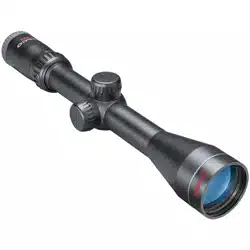Loading ...
Loading ...
Loading ...

4
PRELIMINARY SCOPE ADJUSTMENTS
Before installing the scope, we recommend you set the focus of the eyepiece to fit your individual visual requirement.
Refocusing the ocular distance will result in a sharper reticle focus, an improved optical image, and will help to avoid eye
fatigue when using the scope over prolonged periods of time. To refocus, hold the scope about 3 to 4 inches from your eye
and point at the open sky or other flatly lit area such as a monotone painted wall.
Quickly glance into the scope. If the reticle appears blurred when you first glance at it, it is out of focus. Turn the eyepiece
clockwise or counter clockwise several turns. Glance into the scope again to check the sharpness of the reticle. Remember
to take quick glances, as the eye will compensate for slightly out of focus conditions with prolonged looks. If the reticle still
appears blurred, turn the eyepiece another two or three turns. Repeat this procedure until the reticle is sharp and clearly
defined.
Unless your eyes undergo a significant change over the years, you will not have to make this adjustment again.
ATTACHING A MOUNT, RINGS AND SCOPE TO YOUR RIFLE
WARNING: BEFORE BEGINNING THE MOUNTING PROCEDURE, BE SURE THE ACTION IS OPEN, THE CLIP OR
MAGAZINE IS REMOVED AND THE CHAMBER IS CLEAR. DO NOT ATTEMPT ANY WORK UNTIL YOUR FIREARM
HAS BEEN CLEARED AND DETERMINED TO BE SAFE.
WARNING: IF THE SCOPE IS NOT MOUNTED FAR ENOUGH FORWARD, ITS REARWARD MOTION MAY INJURE
THE SHOOTER WHEN THE RIFLE RECOILS.
In mounting your scope, we recommend that you DO NOT take short cuts as it may lead to damage to either the mounting
system or to the scope. Each mounting system will have its own instructions to follow, and it is best to read the instructions first
to be sure you understand them and have the necessary tools on hand.
We further recommend that you plan to go through the mounting procedure twice. The first time, to be sure everything fits
together and functions properly. On the first run through, please keep the following in mind:
• Before attaching the base, clean the mounting holes in the receiver and the threads of the attaching screws with acetone or
any good solvent to free them of oil or grease.
• If the mount manufacturer has recommended the use of a thread adhesive, do not use it on the first mounting trial. Once
adhesive has set, it is difficult to demount if anything needs correction.
• Be sure the mounting screws do not protrude into the receiver or the barrel.
• When using dovetail mounts, do not use the scope as a lever when installing the scope. The initial resistance to turning
may cause damage to the scope, and is not covered by the warranty. We recommend using a 1” wooden dowel or metal
cylinder to seat the rings.
• Be sure the position of the scope does not interfere with the operation of the action.
• Be sure there is at least 1/8” of clearance between the edges of the rings and any protruding surfaces such as the turret
housing (saddle), power selecting ring, and the flare of the objective bell. Also be sure there is at least 1/8” of clearance
between the objective bell and the barrel.
• You should test position the scope for the proper eye relief. The scope rings should be left loose enough so that the scope
will slide easily. Variable power scopes should be set at the highest magnification when performing this procedure. Mount
the rifle and look through the scope in your normal shooting position.
• Test position the rifle for the proper cheek weld a number of times to ensure that your scope is positioned properly.
• When you are satisfied that everything is okay, demount and start again. This time, seat all screws firmly.
PARALLAX
You may have noticed that placing your eye at different positions behind the scope’s eyepiece causes the reticle
crosshairs to appear to move around to different points on your target. This is called “parallax error” (target and reticle
are not in the same focal plane), and it becomes more noticeable (and more of a problem) at shorter distances and/
or when the scope is set to higher powers. In most cases, parallax will not affect bullet point of impact enough to be of
significant concern in large game hunting situations. All Rimfire scopes are set at the factory to be parallax-free at 50 yards.
Loading ...
Loading ...
Loading ...
